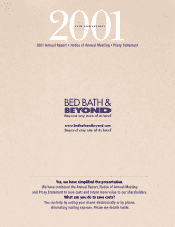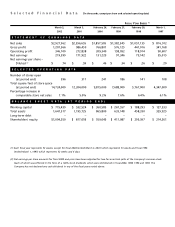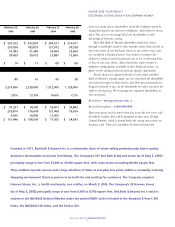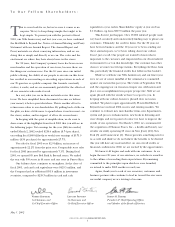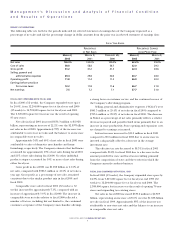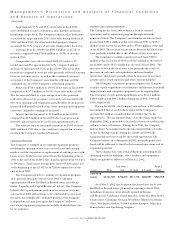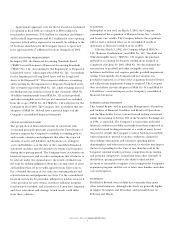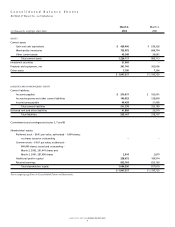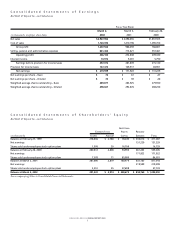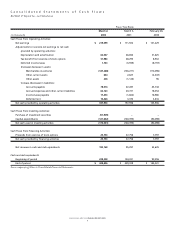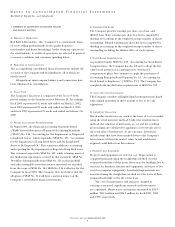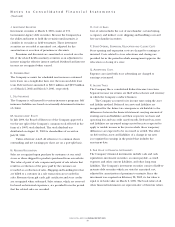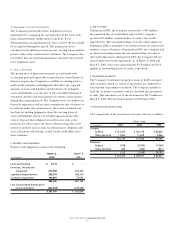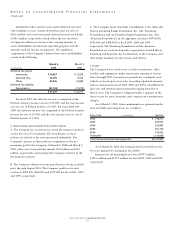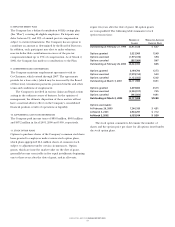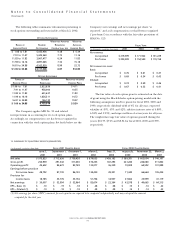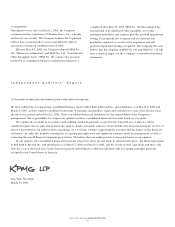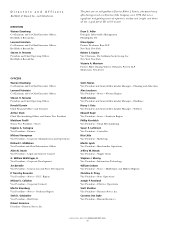Bed, Bath and Beyond 2001 Annual Report Download - page 11
Download and view the complete annual report
Please find page 11 of the 2001 Bed, Bath and Beyond annual report below. You can navigate through the pages in the report by either clicking on the pages listed below, or by using the keyword search tool below to find specific information within the annual report.
BED BATH & BEYOND ANNUAL REPORT 2001
9
1. SUMMARY OF SIGNIFICANT ACCOUNTING POLICIES
AND RELATED MATTERS
A. NATURE OF OPERATIONS
Bed Bath & Beyond Inc. (the “Company”) is a nationwide chain
of stores selling predominantly better quality domestics
merchandise and home furnishings. As the Company operates in
the retail industry, its results of operations are affected by general
economic conditions and consumer spending habits.
B. PRINCIPLES OF CONSOLIDATION
The accompanying consolidated financial statements include the
accounts of the Company and its subsidiaries, all of which are
wholly owned.
All significant intercompany balances and transactions have
been eliminated in consolidation.
C. FISCAL YEAR
The Company’s fiscal year is comprised of the 52 or 53 week
period ending on the Saturday nearest February 28. Accordingly,
fiscal 2001 represented 52 weeks and ended on March 2, 2002;
fiscal 2000 represented 53 weeks and ended on March 3, 2001;
and fiscal 1999 represented 52 weeks and ended on February 26,
2000.
D. RECENT ACCOUNTING PRONOUNCEMENT
In August 2001, the Financial Accounting Standards Board
(“FASB”) issued Statement of Financial Accounting Standards
(“SFAS”) No. 144, “Accounting for the Impairment or Disposal of
Long-Lived Assets,” which supersedes SFAS No. 121, “Accounting
for the Impairment of Long-Lived Assets and for Long-Lived
Assets to Be Disposed Of.” This statement addresses accounting
and reporting for the impairment or disposal of long-lived assets.
The statement supersedes SFAS No. 121, while retaining many of
the fundamental provisions covered by that statement. SFAS No.
144 differs fundamentally from SFAS No. 121 in that goodwill
and other intangible assets that are not amortized are excluded
from the scope of SFAS No. 144. SFAS No. 144 is effective for the
Company in fiscal 2002. The Company does not believe that the
adoption of SFAS No. 144 will have a material impact on the
Company’s consolidated financial statements.
E. EARNINGS PER SHARE
The Company presents earnings per share on a basic and
diluted basis. Basic earnings per share has been computed by
dividing net earnings by the weighted average number of shares
outstanding. Diluted earnings per share has been computed by
dividing net earnings by the weighted average number of shares
outstanding including the dilutive effect of stock options.
F. S TOCK-BASED COMPENSATION
As permitted under SFAS No. 123, “Accounting for Stock-Based
Compensation,” the Company has elected not to adopt the fair
value based method of accounting for its stock-based
compensation plans, but continues to apply the provisions of
Accounting Principles Board Opinion No. 25, “Accounting for
Stock Issued to Employees” (“APB No. 25”). The Company has
complied with the disclosure requirements of SFAS No. 123.
G. CASH AND CASH EQUIVALENTS
The Company considers all highly liquid instruments purchased
with original maturities of three months or less to be cash
equivalents.
H. INVENTORY VALUATION
Merchandise inventories are stated at the lower of cost or market,
using the retail inventory method. Under the retail inventory
method, the valuation of inventories at cost and the resulting
gross margins are calculated by applying a cost-to-retail ratio to
the retail value of inventories. At any one time, inventories
include items that have been marked down to the Company’s
best estimate of their fair market value. Actual markdowns
required could differ from this estimate.
I. PROPERTY AND EQUIPMENT
Property and equipment are stated at cost. Depreciation is
computed primarily using the straight-line method over the
estimated useful lives of the assets (forty years for building; five to
ten years for furniture, fixtures and equipment; and three to five
years for computer equipment). Leasehold improvements are
amortized using the straight-line method over the lesser of their
estimated useful life or the life of the lease.
The cost of maintenance and repairs is charged to
earnings as incurred; significant renewals and betterments
are capitalized. Maintenance and repairs amounted to $34.3
million, $28.4 million and $24.2 million for fiscal 2001, 2000
and 1999, respectively.
Notes to Consolidated Financial Statements
Bed Bath & Beyond Inc. and Subsidiaries

